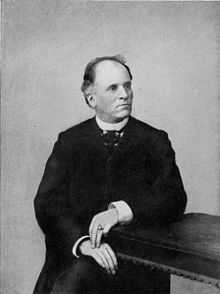Adolph Francis Alphonse Bandelier
| Adolph Francis Alphonse Bandelier | |
|---|---|
 | |
| Born |
August 6, 1840 Bern, Switzerland |
| Died |
March 18, 1914 (aged 73) Sevilla, Spain |
| Residence |
Switzerland United States |
| Nationality | American |
| Fields | Archaeology |
Adolph Francis Alphonse Bandelier (August 6, 1840 – March 18, 1914) was an American archaeologist after whom Bandelier National Monument in New Mexico, United States, is named.
Life
Bandelier was born in Bern, Switzerland. When a youth he emigrated to the United States. As a young man he labored unhappily in his family business. Under the mentorship of the pioneering anthropologist Lewis Henry Morgan he turned to scholarship, more particularly to archaeological and ethnological work among the Native Americans of the southwestern United States, Mexico and South America. Beginning his studies in Sonora (Mexico), Arizona and New Mexico, he made himself the leading authority on the history of this region, and — with F. H. Cushing and his successors — one of the leading authorities on its prehistoric civilization.
In 1892 he abandoned this field for Ecuador, Bolivia and Peru, where he continued ethnological, archaeological and historical investigations. In the first field he was in a part of his work connected with the Hemenway Archaeological Expedition and in the second worked for Henry Villard of New York, and for the American Museum of Natural History of the same city. Bandelier had shown the falsity of various historical myths, notably in his conclusions respecting the Inca civilization of Peru.
While he was in the pueblo of Isleta, he met his long term friends Father Anton Docher,[1] The Padre of Isleta [2] and Charles Fletcher Lummis.
Publications
- Harvard University, Peabody Museum of American Archaeology and Ethnology, Annual Reports, 1877, 1878, 1879:
- On the Art of War and Mode of Warfare of the Ancient Mexicans
- On the Distribution and Tenure of Lands and the Customs with respect to Inheritance among the Ancient Mexicans
- On the Social Organization and Mode of Government of the Ancient Mexicans
- From the Papers of the Archaeological Institute of America, American Series, constituting vols. i.-v.:
- Historical Introduction to Studies among the Sedentary Indians of New Mexico, and Report on the Ruins of the Pueblo of Pecos (1881)
- Report of an Archaeological Tour in Mexico in 1881 (1884)
- Final Report of Investigations among the Indians of the South-western United States (1890—1892, 2 vols.)
- Contributions to the History of the South-western Portion of the United States carried on mainly in the years from 1880 to 1885 (1890)
- "The Romantic School of American Archaeologists" (New York Historical Society, 1885)
- The Gilded Man (El Dorado) and other Pictures of the Spanish Occupancy of America (1893)
- On the Relative Antiquity of Ancient Peruvian Burials (American Museum of Natural History, Bulletin, v. 30, 1904)
- Aboriginal myths and traditions concerning the island of Titicaca, Bolivia. (1904)
- The Journey of Alvar Nuñez Cabeza de Vaca ... from Florida to the Pacific, 1528-1536 (editor, translated into English by his wife; 1905).
- The Delight Makers, a novel of Pueblo Indian life
- The Islands of Titicaca and Koati(1910)
- He contributed over 60 articles to the Catholic Encyclopedia
Notes
References
- Biography at BookRags
 Chisholm, Hugh, ed. (1911). "Bandelier, Adolph Francis Alphonse". Encyclopædia Britannica (11th ed.). Cambridge University Press.
Chisholm, Hugh, ed. (1911). "Bandelier, Adolph Francis Alphonse". Encyclopædia Britannica (11th ed.). Cambridge University Press. Wilson, James Grant; Fiske, John, eds. (1900). "Bandelier, Adolph Francis Alphonse". Appletons' Cyclopædia of American Biography. New York: D. Appleton.
Wilson, James Grant; Fiske, John, eds. (1900). "Bandelier, Adolph Francis Alphonse". Appletons' Cyclopædia of American Biography. New York: D. Appleton. Rines, George Edwin, ed. (1920). "Bandelier, Adolph Francis Alphonse". Encyclopedia Americana.
Rines, George Edwin, ed. (1920). "Bandelier, Adolph Francis Alphonse". Encyclopedia Americana.- Keleher, Julia M.; Chant, Elsie Ruth (2009). The Padre of Isleta: The Story of Father Anton Docher. Sunstone press Publishing. ISBN 978-0-86534-714-4.
- Samuel Gance, Anton ou la trajectoire d'un père, The novel of father Anton Docher. L'Harmattan, Paris, 2013, 208 p. ISBN 978-2336290164
External links
| Wikisource has original works written by or about: Adolph Francis Alphonse Bandelier |
- Works by Adolph Francis Alphonse Bandelier at Project Gutenberg
- Works by or about Adolph Francis Alphonse Bandelier at Internet Archive
- Publications by and about Adolph Francis Alphonse Bandelier in the catalogue Helveticat of the Swiss National Library
|